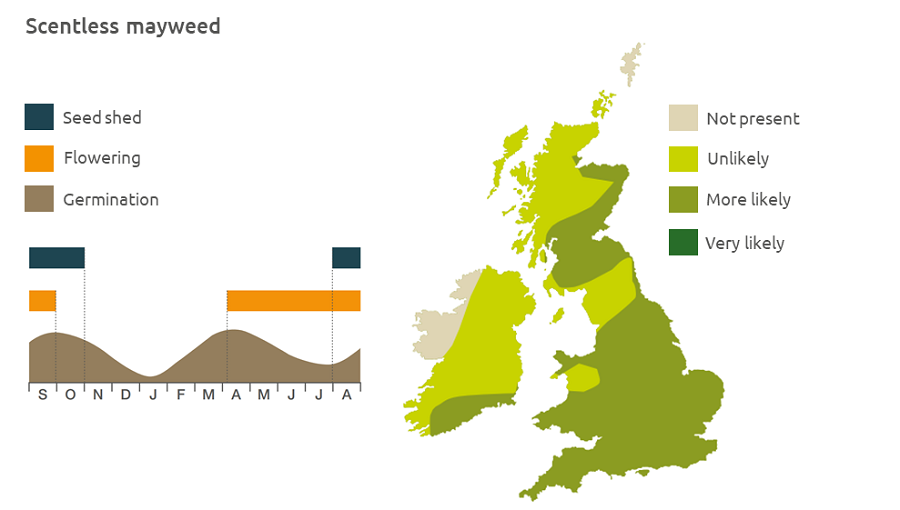- Home
- Knowledge library
- Distribution and biology of scentless mayweed in the UK
Distribution and biology of scentless mayweed in the UK
Scentless mayweed is a competitive weed in many arable crops including oilseed rape and winter wheat. Find out how to identify and control it.
Overview
Scentless mayweed (Tripleurospermum inodorum) is the most widespread of the mayweeds found on arable land. It can be a problem in both winter- and spring-sown crops. It is competitive in wheat and oilseed rape and the seeds can clog sieves and contaminate grain samples.
Plants of scentless mayweed can overwinter from later germination. Newly emerged plants are fairly slow-growing. It reproduces from seed moved by humans, birds or stock.
- It is particularly competitive in winter wheat, winter oilseed rape and spring crops
- Some populations are associated with herbicide resistance
- It has value to biodiversity
Weed Resistance Action Group (WRAG)
Description
It is a much-branched annual dicotyledon, 10–80 cm tall, with finely divided feathery green leaves. Scentless mayweed often sprawls along the ground but may be more upright when supported by a crop.
Key features
Flowers: Scentless mayweed flowers are flat or convex. When the daisy-like flowerhead is split, the end of the stem to which the petals attach is solid.
Lookalikes
Scentless mayweed may be confused with scented mayweed: the mayweeds are difficult to distinguish in their non-flowering stages

Location and life cycle

Geographic distribution
Scentless mayweed is mainly a lowland species growing to a maximum altitude of 500 m, in open habitats such as arable soils and less frequently other disturbed sites.
Soil type
It prefers warm, fertile and heavy soils with pH >4.5 and preferably >5.5.
Seed statistics
- Seed longevity: >5 years
- Germination depth: 5 cm
- Seed weight: 0.3 mg
- Seeds/flowers: 1
- Seeds/plant: 10,000–200,000
Management
Because of its long period of emergence, it may need repeated herbicide treatments.
For advice on herbicides, please speak with your agronomist or adviser.
Herbicide resistance
ALS-resistant populations of scentless mayweed have been identified in two counties in England and one in Scotland but the true number of cases is probably under recorded.
Studies with the Scottish population showed that resistance was conferred by a Pro-197-Gln target site mutation.
If resistance is confirmed, use alternative (non-ALS) herbicides.
The results of regular herbicide resistance tests (on seeds or plants) provide a strong indication of the unique resistance profiles present across each field.
- Collect mayweed when mature (usually, in August)
- Ensure no petals remain and that the central dome is yellow/brown
- Pull up/cut at the plant base large quantities of weed and place in a large paper sack – do not pack too tightly but allow enough room for air to circulate
- Place the open sack in a well-ventilated area where the plants can dry out; as they dry, seeds will fall from the heads to the bottom of the sack
- When dry, remove the straw, shaking any loose seeds into the sack
- When the straw has been removed, tip the seeds into an envelope
How to detect herbicide resistance in arable weeds
When was this information last updated?
This page is based on content from the encyclopaedia of arable weeds publication. Since it was first released in 2008, the publication has been redesigned several times but not revised. However, it remains a good foundation for general information on the distribution and biology of weeds.

